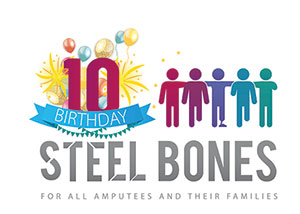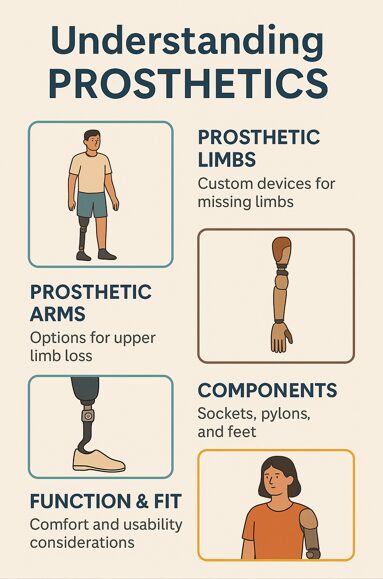Navigating life after limb loss can be overwhelming — and one of the biggest steps is understanding what prosthetic options are available to you. Whether you’re newly amputated or looking to explore alternatives to your current limb, knowing what’s offered through the NHS can help you make informed, confident decisions. Please note: this guide is intended as general information only. Every amputee’s journey is unique, and prosthetic needs vary depending on individual health, mobility, and goals. Always speak with your clinical team to find the best option for your personal circumstances.
1. Basic Functional Prosthetics
These are designed for essential everyday use, like walking around the home, standing up, or getting to appointments.
-
Lightweight and reliable
-
Often simpler in design
-
Suitable for lower activity levels
-
Ideal for those who want comfort and ease over advanced tech
2. Activity Prosthetics
Also called “intermediate” limbs, these are suited to people with an active lifestyle or higher mobility goals. These are rarely available on the NHS, who are keen to ensure your porsthetic enabled you to achieve all you need it too but some activity prostehtics can provide:
-
Stronger components for more wear
-
May include some mechanical knee or foot joints
-
Designed for outdoor walking, light sport, or part-time work
3. Myoelectric Prosthetics (for arms/hands)
Used for upper limb amputees, these electronic limbs use muscle signals from the remaining arm to control movement.
-
Allows grip and release of objects
-
Very helpful for daily tasks like holding a cup or bag
-
Often requires practice to master
-
Available on the NHS after careful assessment
4. Cosmetic (Passive) Prosthetics
These limbs are designed for appearance rather than function. They don’t move but can help with symmetry, posture, or clothing fit.
-
Often very realistic in appearance
-
Lightweight and easy to wear
-
Sometimes used for social confidence or comfort
- Many NHS Clincis now offer LimbArt Covers: https://limb-art.com/
5. Specialist Prosthetics
In some cases, the NHS may provide tailored prosthetics such as:
-
Waterproof prosthetics for use in the shower or swimming pool
-
Sports prosthetics for hobbies like running or cycling (these may require a funding application)
-
Paediatric limbs designed for growing children, which are replaced more frequently
These are limited and very much dependent one ach individual’s health needs.
You can also discuss options with private providers: https://steelbone.co.uk/major-prosthetic-providers-in-the-uk/
⚕️ How Are Prosthetics Chosen?
A multidisciplinary team — including a prosthetist, physiotherapist, occupational therapist, and consultant — will work with you to decide the best prosthetic for your needs.
Factors they’ll consider:
-
Your goals (walking? working? sport?)
-
Stability and safety
-
Energy levels and stamina
-
Funding availability for certain types
️ Can Prosthetics Be Upgraded?
Sometimes. If your condition changes or your activity level increases, you may be reassessed for a more advanced limb. You can also ask about additional limbs for different purposes (e.g., a waterproof leg for showering).
♂️ Steel Bones Tip:
Ask lots of questions at your appointments. If you’re unsure what’s available or feel your prosthetic doesn’t match your needs, you have the right to ask for a review.
You’re Not Alone
Getting used to a prosthetic can take time. Many amputees need multiple fittings and adjustments — and that’s completely normal. You’re not expected to have it all figured out right away.
Whether you’re just starting the journey or looking to switch limbs, know that support is always available — from professionals and from peer-led groups like Steel Bones.
Got Questions?
Reach out to us at Steel Bones or speak to your prosthetic centre. We’re always happy to share experiences and signpost to trusted resources.


High I’m a 47 year old, had a double BKA due to diabetic troubles which have now been solved, but I wish to go back to work and to do sports and showers so forth. At the moment I can’t do any of things, because I haven’t even been educated on these things just me looking on the Internet for my own interest. I would love for someone to get in contact with me to see what us available for a young man who really wishes to carry on his life as much as possible. I have one prosthetic leg which weighs a tonne I don’t think I’ll be able to do much with two of them but I want too, really want to carry on my life as much as I can even with a cost. Please can someone get in touch and explain what us available for me many thanks Adam Davidson. 39 glastonbury close. Belmont. Hereford. Herefordshire. HR2 7YL. Tel no : 07866352369. Email : apdavidson2010@gmail.com.
Hello my daughter has been waiting two years for her NHS c-leg we had to buy her last one which is now out of warranty. In this two years she has outgrown her private socket developed a medial roll, her gait is visibly worse and her back looks twisted. We really need the new nhs leg to fit really comfortably but so far it is causing cuts after 20 mins wear.
We have been back to the private clinic to see if anything new we should consider. They showed us a new style of socket DSTF and also said the Navii is available on nhs.
Will we need to wait until this next nhs c-leg is out of warranty before asking to try a navii knee with the new style socket?